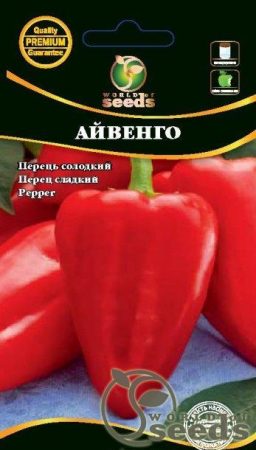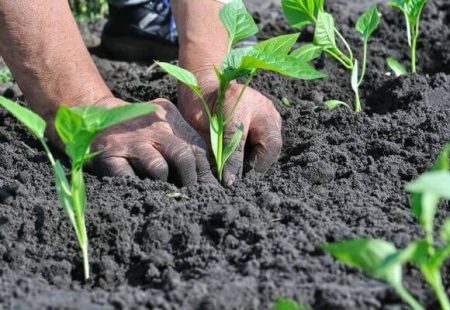 Sweet pepper dishes are not only an adornment of any table, but also year-round enrich it with vitamins, minerals and other useful substances. And its rich taste gives unforgettable pleasure even to obvious gourmets. That is why gardeners turned their attention to him. One of the favorites was Aivengo pepper, which is also part of the group of early varieties of this culture.
Sweet pepper dishes are not only an adornment of any table, but also year-round enrich it with vitamins, minerals and other useful substances. And its rich taste gives unforgettable pleasure even to obvious gourmets. That is why gardeners turned their attention to him. One of the favorites was Aivengo pepper, which is also part of the group of early varieties of this culture.
Description
The fruits of the culture can already be observed a hundred days after planting. They are smooth, conical, but not  elongated. Each of them weighs from 90 to 130 grams. The wall thickness reaches 8-9 mm, so the pepper is juicy and fleshy. In the process of ripening, it acquires a yellowish-cream hue, closer to the harvest, the peppers turn red. From one hectare, experienced gardeners collect up to 8-10 thousand kilograms of Ivanhoe pepper.
elongated. Each of them weighs from 90 to 130 grams. The wall thickness reaches 8-9 mm, so the pepper is juicy and fleshy. In the process of ripening, it acquires a yellowish-cream hue, closer to the harvest, the peppers turn red. From one hectare, experienced gardeners collect up to 8-10 thousand kilograms of Ivanhoe pepper.
Beneficial features
Taste the culture data conquer once and for all: the vegetable is juicy, sweet and fragrant. Pepper is enriched with minerals and vitamins so beneficial for health:
- potassium;
- phosphorus;
- magnesium
- sodium;
- calcium
- B vitamins;
- vitamins - C, A, E.
Of course, both gardeners and nutritionists recommend eating peppers in their raw form, but even during heat treatment, some of the nutrients are preserved. A large amount of vitamin C makes it desirable in the winter, even as a salad. Moreover, the vegetable is combined with virtually all products.
Distinctive qualities
Pepper is well transported, stored in cool cellars for a long time. This variety is resistant to many vegetable "diseases". But the weather conditions on it can have a detrimental effect. Therefore, experienced gardeners recommend growing Ivanhoe peppers in greenhouse conditions.
Landing conditions
Since the vegetable is a southern fruit, it is planted on its native land at the beginning of February, so in cooler countries exactly one season is enough for pepper to ripen. Experienced gardeners replaced the missing period of garden cultivation, planting pepper seedlings. This gives additional ripening time and the ability to harvest an early crop. Before planting, seeds should be carefully selected, which are then placed for 15-20 minutes in a light solution of potassium permanganate. After drying, the seeds are placed in a separate bowl with soil, in which they will sprout in a couple of weeks. The strongest of them should be transplanted into separate plastic cups.
Before replanting the fruits, you should prepare the soil well: thoroughly rid it of weeds, loosen it well, and fertilize it if possible. Usually seedlings are transferred to the soil 60 days after planting seeds. The distance between the holes can be chosen small (25 cm), pepper "Ivanhoe" suffers a dense landing. In colder areas, it is best to plant pepper seeds at the very end of winter, and to transfer sprouts to the ground in early summer.

Land for landing every year should be in a new place. You can plant it in places where cabbage or cereals / legumes previously grew. But with the land where garden crops such as potatoes, tomatoes, eggplant or zucchini grew, it’s better not to risk it. Peppers can return to their territory no earlier than three years later. It is good if the land in the garden contains not only a lot of peat, but also manure, humus, sawdust and sand.
Seedling method is a necessary measure, and not natural, therefore, Ivanhoe pepper behaves badly when transplanted. Novice gardeners should behave as carefully as possible so as not to damage the roots and stems of young shoots.The weather is best to choose clear, sunny, despite the greenhouse conditions, but you need to plant in the evening.
Care
Nothing should grow next to pepper; he "does not like it." Wells should be well loosened, moist. Leaflets of seedlings should not be located high above the ground, 1.5-2 cm will be enough. In the process of cultivation, this culture should not be ignored at all. Constantly loosen the holes, water and fertilize them. The first top dressing is done at a temperature of at least 20 g. C. During the period of active life, the plants well loosen the soil 4-5 times and once they are spudded. This makes it possible to saturate it with oxygen and remove weed plants from the soil. Pepper loves moisture, but there is a watering scheme for it:
- when landing in open ground;
- 5 days after pepper was transplanted;
- not less than 10 days before they were going to harvest;
- water the remaining bushes after harvesting.
As a top dressing, you can choose a product called "Energen Extra" in capsules. Aivengo pepper should be protected from aphids, ticks and cobwebs. Resistance to them can be provided with a soap solution or ash. Soap solution should be washed with a stream or from a watering can all the leaves of the bush. It is also necessary to wash the ground, in which there are bushes, to flush pests with water.
Also find out Characteristics of Pepper Bogatyr.
Processing with wood ash is as follows: a glass of this product is diluted in 4.5-5 liters of water and insisted for half a day, then the leaves are carefully treated. Means such as Fitoverm, Actellik will also help get rid of ticks.
Reviews
Feedback from gardeners about Ivanhoe pepper is always positive, although it is not so easy to care for.
Svetlana
“At first I couldn’t get in touch with this kind of pepper. But gradually my friendship with him improved, I realized how whimsical he was and what exactly he needed. Now - this is my favorite culture, which is always on our table. ”
Galina
“I try to grow Ivanhoe peppers without any chemical intervention. The maximum that I use is a soap solution. Since my garden is small, I process everything manually, including foliage of peppers. Just then pepper will bring the greatest benefit to our table. ”
Tatyana
“Aivengo pepper is the juiciest of all varieties of pepper that I know of. In the greenhouse, I managed to grow it even in Siberia. It requires maximum attention of the owner, but it does not burden, but then the work is compensated by a high yield.
Lily
“The high yield of pepper strikes me every year. It would seem that there are a lot of foliage on the bushes, but still there is a place for fruits! Of course, we must not forget to look after him and spend time fighting with parasitic organisms. ”




 Calorie pepper stuffed with meat and rice - BZHU per 100 grams
Calorie pepper stuffed with meat and rice - BZHU per 100 grams Gorky pepper - the best varieties for open ground
Gorky pepper - the best varieties for open ground Hot pepper seeds - the best varieties for open ground and reviews
Hot pepper seeds - the best varieties for open ground and reviews Capsicum tincture for hair - how to use and reviews
Capsicum tincture for hair - how to use and reviews